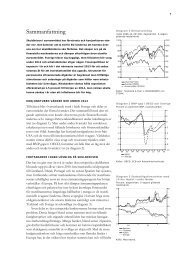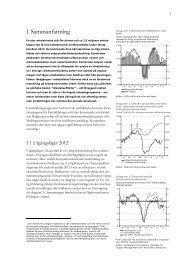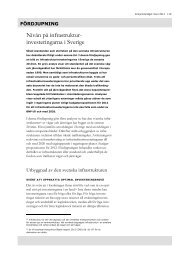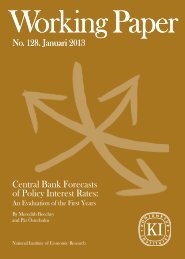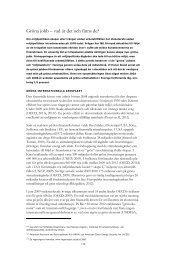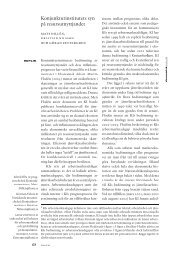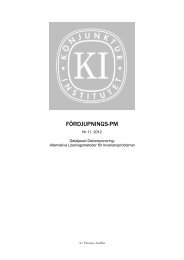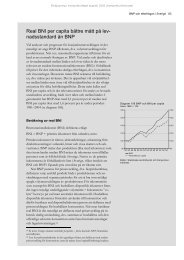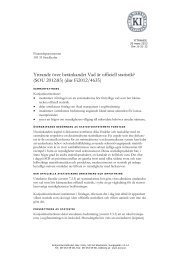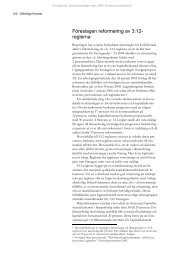36 Macroeconomic Development and Economic Policy <strong>2012</strong>–2016mented in Spain and Italy, for example, and the innate dynamismof market forces, point to more gradual cost increases inthe less competitive countries. <strong>The</strong> euro area can thereby approachthe internal balance that will strengthen economicgrowth in the deficit countries. This will enhance the credibilityof claims that solvency can be achieved for banks and governments,which would support recovery in the euro area. 19 Despitethese measures, GDP growth in the next few years will be low,according to the forecast. Resource utilization will probably notreturn to normal until the end of the current decade.An Alternative Scenario: Recovery in theEuro Area Delayed 20RECESSION IN THE EURO AREA MORE PROLONGED ANDMORE SEVEREA basic assumption in the scenarios is that the concern aboutthe solvency of banks and countries persists next year and thatthe adjustment of costs is more sluggish than in the forecast.One reason for studying such scenarios is the high degree ofuncertainty surrounding the assessment in the forecast of thetiming and effects of necessary political decisions. It is not improbablethat the measures currently under consideration will beeither torpedoed or once again regarded as inadequate. In thatcase the uncertainty about government finances and the futureof the currency union will put a brake on growth in the euro areanext year as well, when growth will be positive, though low, inthe forecast. Another reason for such a development would bethat the structural reforms mentioned above might not have theintended effect, or might be repealed. Not the least importantfactor in this connection is the uncertainty about the politicalfuture in Italy, where parliamentary elections will be held in thespring of 2013. <strong>The</strong> current prime minister, Mario Monti – regardedby many as a key figure in the implementation of thereforms – has announced that he will not be available after theelection. It is not inconceivable that a new government wouldhave a less ambitious agenda for structural reforms than the19 Some support to the claim that the process of cost adjustment has begun can befound in recent developments.20 In <strong>The</strong> <strong>Swedish</strong> <strong>Economy</strong>, <strong>August</strong> 2011, an alternative scenario was presented inthe special analysis “Effects of a More Severe Debt Crisis in the Euro Area.” <strong>The</strong>focus of that special analysis was a severe recession in <strong>2012</strong> caused by increasinglyserious financing problems for banks and countries in the euro area. <strong>The</strong> alternativescenario presented here focuses instead on a more prolonged process of achievingcredibility for the solvency of governments and banks, as well as more sluggishadjustment of prices in the euro area. Both of these factors lead to slower realeconomic recovery in the euro area.
<strong>The</strong> <strong>Swedish</strong> <strong>Economy</strong> <strong>August</strong> <strong>2012</strong> 37current one. Nor can one exclude the possibility of politicalturbulence and repealed reforms in countries such as Spain.Diagram 53 GDP in Euro AreaPercentage change44VERY LOW GROWTH IN THE EURO AREA IN 2013–2014As a consequence of the prolonged uncertainty, GDP growthwill be substantially lower in the euro area in the next few yearscompared to the NIER’s forecast. Next year, euro-area GDPwill decrease by 0.4 percent. Output will subsequently beginrising again in 2014. Hardest hit by the weaker development ofGDP will be the countries with weak government finances, butGDP will also increase more slowly in the core countries of theeuro area, for example Germany and France. Overall, growth inthe euro area in 2013 and 2014 will be roughly 1 percentagepoint lower per year than in the forecast (se Diagram 53). Thismeans that the output gap will be significantly lower in the euroarea in the next few years (see Diagram 54).GLOBAL GROWTH WILL ALSO BE LOWER<strong>The</strong> uncertainty and the weakness of demand in the euro areaalso affect growth in other countries. <strong>The</strong> impact is apparentprimarily in the form of reduced world trade, but the uncertaintyalso contributes to increased precautionary saving and lowerinvestment in other countries. In total, worldwide GDP growthis 0.4 percentage points lower per year in 2013–2014, and thegrowth of the market for <strong>Swedish</strong> exports about 1.5 percentagepoints lower per year in the same period, compared to the forecast(see Diagram 55). <strong>The</strong> reason why the effect on the growthof the market for <strong>Swedish</strong> exports is not greater, despite thesubstantially lower growth in the euro area, is that the downturnhas a heavier impact on southern European countries that areless important as trading partners than countries like Germanyand Finland.LOW INFLATION AND VERY LOW POLICY RATES ABROADFOR A PROLONGED PERIODAs an effect of the lacklustre development in other countries,resource utilization decreases, putting downward pressure oninflation, primarily in the euro area, but also in other countries,reducing it by several tenths of a percentage point in the nextfew years compared to the forecast. As a result, many centralbanks keep their policy rates at low levels. <strong>The</strong> ECB and theFederal Reserve, whose policy rates in the forecast are at a levelthat can be considered a floor until the end of 2014, are not in aposition to lower their rates. Instead, central banks, primarily theECB, wait somewhat longer to raise policy rates and then do soat a more deliberate pace than in the forecast in 2015–2016 (seeDiagram 56).20-2-4-6000204060810Forecast, <strong>August</strong> <strong>2012</strong>Lower euro area growthSources: Eurostat and NIER.1214161820-2-4-620Diagram 54 Output Gap in Euro AreaPercent420-2-4-6000204060810Forecast, <strong>August</strong> <strong>2012</strong>Lower euro area growth12Sources:OECD, IMF and NIER.Diagram 55 <strong>Swedish</strong> Exports MarketPercentage change151050-5-10141618420-2-4-620-15-1500 02 04 06 08 10 12 14 16 18 20Forecast, <strong>August</strong> <strong>2012</strong>Lower euro area growthSources: OECD, IMF and NIER.151050-5-10



